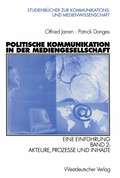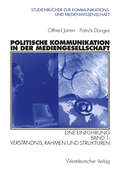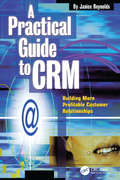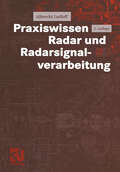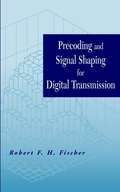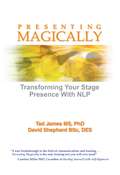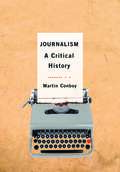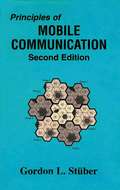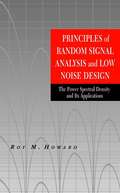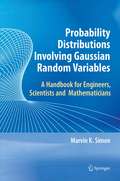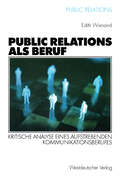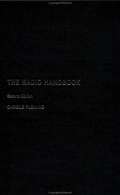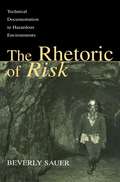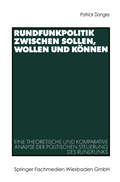- Table View
- List View
Politische Kommunikation in der Mediengesellschaft: Eine Einführung Band 2: Akteure, Prozesse und Inhalte (Studienbücher zur Kommunikations- und Medienwissenschaft)
by Otfried Jarren Patrick DongesIn Band 2 stehen Akteure, Medien und politische Prozesse im Mittelpunkt. Analysiert werden die unterschiedlichen Formen politischer Prozesse. Aus der Sicht politischer Akteure werden dann Strategien, Instrumente und Formen der politischen Public Relations systematisch dargestellt. Die Zusammenarbeit zwischen Akteuren aus Politik, PR und Journalismus werden theoretisch wie empirisch betrachtet und ihre Interaktionen als Handlungssystem interpretiert. Abschließend werden zentrale Befunde zur Politik der Medien vorgestellt und politische Medieninhalte dabei als Handlungs- und Strukturergebnis begriffen.
Politische Kommunikation in der Mediengesellschaft: Eine Einführung (Studienbücher zur Kommunikations- und Medienwissenschaft)
by Otfried Jarren Patrick Donges„Politische Kommunikation in der Mediengesellschaft“ ist eine zunächst auf zwei Bände angelegte Einführung in dieses immer wichtiger werdende Forschungsfeld. Zu Beginn von Band 1 werden die unterschiedlichen theoretischen Ansätze diskutiert, mit deren Hilfe man Politische Kommunikation analysieren und verstehen kann. Danach werden mit dem politischen System der Rahmen und mit Öffentlichkeit der Raum vorgestellt, in denen Politische Kommunikation stattfindet. Zentral ist dabei das intermediäre System, das aus Parteien, Verbänden und Neuen Sozialen Bewegungen als Akteuren besteht. Abschließend werden Medien und Medienstrukturen als Handlungsrahmen für diese politischen Akteure analysiert.
A Practical Guide to CRM: Building More Profitable Customer Relationships
by Janice ReynoldsIn today's global economy the customer has more and better choices than ever before, bringing on one of the biggest challenges the business community faces today - customer loyalty and retention. To thrive in today's customer-driven economy a company need
Praxiswissen Radar und Radarsignalverarbeitung
by Albrecht K. LudloffEinleitend werden die Radargleichung als ein Werkzeug zum Radarentwurf und wichtige Begriffe der Radartechnik erklärt. Grundlagen und moderne Verfahren der Radarsignalverarbeitung und des Sendesignalentwurfs werden am Beispiel der großen Klasse der MTI- und Pulsdoppler- oder MTD-Radare behandelt, ergänzt jeweils durch praktische Beispiele. Der Anhang enthält eine Zusammenfassung der Theorie determinierter Signale und linearer Systeme. In der 3. Auflage wurde das Kapitel Pulskompression überarbeitet, das Kapitel CFAR-Methoden wurde überarbeitet und erweitert.
Precoding and Signal Shaping for Digital Transmission (Wiley - IEEE)
by Robert F. FischerProvides a step-by-step description of the basics of precoding and signal shaping. * Illustrates theory with examples from wireline and wireless communications. * Discusses the role of precoding and signal shaping algorithms in communications standards.
Presenting Magically: Transform your stage presence with NLP
by Tad James David ShephardWhether you are a newcomer or a seasoned professional, Presenting Magically will provide you with masterful tips and techniques to transform your presenting skills. " A treasure trove of information on how to acquire the skills of a world class presenter." Judith E. Pearson PhD, Anchor Point
The Press and Popular Culture (PDF)
by Dr Martin ConboyIn this book, Martin Conboy explores the complex and dynamic relationship between the popular press and popular culture. Rejecting approaches to popular culture which restrict themselves to the contemporary, Conboy argues for the importance of an historical perspective in understanding the contemporary relationship between the popular and the press. The Press and Popular Culture offers: #65533; A much-needed critical history of the popular press - from the Early Modern Period to the present day. #65533; A comparative analysis of the emergence of the popular press in the United States and Britain. #65533; An approach to the role played by the popular press in the formation of popular culture which emphasizes the use of language. Moving beyond historical analysis to the present day, the book concludes with an analysis of the popular press in a globalized media environment. Drawing on contemporary examples and discussion from Britain, Europe and the United States enables Conboy to situate the debate outside of the narrow confines of national border, as part of a debate about how the popular is being reconfigured in the popular press as part of a global strategy while retaining its essential appeal to local readerships; and meeting challenges by recombining aspects of its traditional rhetorical appeal.
Principles of Mobile Communication
by Gordon L. StüberThis authoritative treatment of the fundamentals of mobile communications stresses the "fundamentals" of wireless and mobile communications engineering important for the design of "any" wireless system. The book differs from others in the field by stressing mathematical modelling and analysis.
Principles of Random Signal Analysis and Low Noise Design: The Power Spectral Density and its Applications (Wiley - IEEE)
by Roy M. HowardDescribes the leading techniques for analyzing noise. Discusses methods that are applicable to periodic signals, aperiodic signals, or random processes over finite or infinite intervals. Provides readers with a useful reference when designing or modeling communications systems.
Probability Distributions Involving Gaussian Random Variables: A Handbook for Engineers and Scientists
by Marvin K. SimonThis handbook, now available in paperback, brings together a comprehensive collection of mathematical material in one location. It also offers a variety of new results interpreted in a form that is particularly useful to engineers, scientists, and applied mathematicians. The handbook is not specific to fixed research areas, but rather it has a generic flavor that can be applied by anyone working with probabilistic and stochastic analysis and modeling. Classic results are presented in their final form without derivation or discussion, allowing for much material to be condensed into one volume.
Professing Rhetoric: Selected Papers From the 2000 Rhetoric Society of America Conference
by Frederick J. Antczak Geoffrey D. KlingerRepresenting current theory and research in rhetoric, this volume brings together scholarship from a variety of orientations--theoretical, critical, historical, and pedagogical. Some contributions cover work that has previously been silenced or unrecognized, including Native American, African American, Latino, and women's rhetorics. Others explore rhetoric's relationship to performance and to the body, or to revising canons, stases, topoi, and pisteis. Still others are reworking the rhetorical lexicon to comprise contemporary theory. Among these diverse interests, rhetoricians find common themes and share intellectual and pedagogical enterprises that hold them together even as their institutional situations keep them apart. Topics discussed in this collection include: *Rhetoric as figurality; comparative and contrastive rhetorics; rhetoric and gender; and rhetorics of science and technology; *Rhetoric and reconceptions of the public sphere; rhetoric and public memory; and rhetorics of globalization and social change, including issues of race, ethnicity, and nationalism; *Rhetoric's institutionalized place in the academy, in relation to other humanities and to the interpretive social sciences; and *The place of rhetoric in the formation of departments and the development of pedagogy With its origins in the 2000 Rhetoric Society of America (RSA) conference, this volume represents the range and vitality of current scholarship in rhetoric. The conversations contained herein indicate that professing rhetoric is, at the turn of the millennium, an intellectual activity that engages with and helps formulate the most important public and scholarly questions of today. As such, it will be engaging reading for scholars and students, and is certain to provoke further thought, discussion, and exploration.
Professing Rhetoric: Selected Papers From the 2000 Rhetoric Society of America Conference
by Frederick J. Antczak Cinda Coggins Geoffrey D. KlingerRepresenting current theory and research in rhetoric, this volume brings together scholarship from a variety of orientations--theoretical, critical, historical, and pedagogical. Some contributions cover work that has previously been silenced or unrecognized, including Native American, African American, Latino, and women's rhetorics. Others explore rhetoric's relationship to performance and to the body, or to revising canons, stases, topoi, and pisteis. Still others are reworking the rhetorical lexicon to comprise contemporary theory. Among these diverse interests, rhetoricians find common themes and share intellectual and pedagogical enterprises that hold them together even as their institutional situations keep them apart. Topics discussed in this collection include: *Rhetoric as figurality; comparative and contrastive rhetorics; rhetoric and gender; and rhetorics of science and technology; *Rhetoric and reconceptions of the public sphere; rhetoric and public memory; and rhetorics of globalization and social change, including issues of race, ethnicity, and nationalism; *Rhetoric's institutionalized place in the academy, in relation to other humanities and to the interpretive social sciences; and *The place of rhetoric in the formation of departments and the development of pedagogy With its origins in the 2000 Rhetoric Society of America (RSA) conference, this volume represents the range and vitality of current scholarship in rhetoric. The conversations contained herein indicate that professing rhetoric is, at the turn of the millennium, an intellectual activity that engages with and helps formulate the most important public and scholarly questions of today. As such, it will be engaging reading for scholars and students, and is certain to provoke further thought, discussion, and exploration.
Protocols for High Speed Networks: 7th IFIP/IEEE International Workshop, PfHSN 2002, Berlin, Germany, April 22-24, 2002. Proceedings (Lecture Notes in Computer Science #2334)
by Georg Carle Martina ZitterbartThis workshop on “Protocols for High-Speed Networks” is the seventh in a s- cessful series of international workshops, well known for their small and focused target audience, that provide a sound basis for intensive discussions of hi- qualityand timelyresearch work. The location of the workshop has alternated between Europe and the United States, at venues not onlyworth visiting for the workshop, but also for the distinct impressions theyleave on the participants. The ?rst workshop was held in 1989 in Zurich. Subsequentlythe workshop was moved to Palo Alto (1990), Stockholm (1993), Vancouver (1994), Sophia-Antipolis/Nice (1996), and Salem (1999). In 2002, the workshop was hosted in Berlin, the capital of Germany. PfHSN is a workshop providing an international forum that focuses on issues related to high-speed networking, such as protocols, implementation techniques, router design, network processors and the like. Although the topics have shifted during the last couple of years, for example, from parallel protocol implemen- tions to network processors, it could be observed that high speed remains a very important issue with respect to future networking. Traditionally, PfHSN is a r- ativelyfocused and small workshop with an audience of about 60 participants.
Public Health Communication: Evidence for Behavior Change (Routledge Communication Series)
by Robert HornikThis volume argues the case that public health communication has affected health behavior. It brings together 16 studies of large-scale communication in a variety of substantive health areas--tobacco, drugs, AIDS, family planning, heart disease, childhood disease, highway safety--prepared by the authors who did the original research. These studies show important effects and illustrate the central conditions for success. The book also includes complementary analytic chapters which provide a meta-analysis of published results, some approaches to developing communication interventions, and alternative methods for evaluation of public health communication projects. Including studies based on communication programs in the United States, as well as projects done elsewhere in the world, including Europe, Africa, Asia and Latin America, this book: *offers a broad presentation of the alternative research designs that have been used to evaluate public health communication programs; *includes a great range of approaches from field experiments and natural experiments to simple before-after and complex time series designs, using data gathered from individuals and from archives; and *utilizes an innovative perspective on how to exercise public health communication from a leading and thoughtful practitioner. As such, it is required reading for scholars, students, practitioners, and policymakers in public health, health communication, health psychology, and related areas.
Public Health Communication: Evidence for Behavior Change (Routledge Communication Series)
by Robert C. HornikThis volume argues the case that public health communication has affected health behavior. It brings together 16 studies of large-scale communication in a variety of substantive health areas--tobacco, drugs, AIDS, family planning, heart disease, childhood disease, highway safety--prepared by the authors who did the original research. These studies show important effects and illustrate the central conditions for success. The book also includes complementary analytic chapters which provide a meta-analysis of published results, some approaches to developing communication interventions, and alternative methods for evaluation of public health communication projects. Including studies based on communication programs in the United States, as well as projects done elsewhere in the world, including Europe, Africa, Asia and Latin America, this book: *offers a broad presentation of the alternative research designs that have been used to evaluate public health communication programs; *includes a great range of approaches from field experiments and natural experiments to simple before-after and complex time series designs, using data gathered from individuals and from archives; and *utilizes an innovative perspective on how to exercise public health communication from a leading and thoughtful practitioner. As such, it is required reading for scholars, students, practitioners, and policymakers in public health, health communication, health psychology, and related areas.
Public Information Campaigns and Opinion Research: A Handbook for the Student and Practitioner (PDF)
by Dr Andrea Roemmele Professor Hans-Dieter KlingemannThis handbook draws on multidisciplinary insights and the experiences of academics and campaign practitioners to provide a comprehensive guide and introduction to planning, implementing and measuring public information and communication campaigns. It outlines the basic theoretical approaches and provides practical examples from a variety of both national and international information and communication campaigns within and across Europe. Public opinion information and campaign strategies in a recent American state election campaign are used to contrast the different perspectives and experiences in the United States. The handbook concludes by demonstrating how to measure effects, causality and public opinion change to determine what the campaign accomplished. A helpful summary and checklist for the student and practitioner using survey research is provided at the end.
Public Relations als Beruf: Kritische Analyse eines aufstrebenden Kommunikationsberufes (Public Relations)
by Edith WienandDie vorliegende Arbeit versteht sich als umfassende Beschreibung des PR-Berufsfeldes. Sie stellt sich dabei den grundlegenden Fragen berufssoziologischer Theorien und untersucht ihre Anwendbarkeit auf den PR-Beruf, bettet die berufliche Entwicklung der PR in den übergeordneten Kontext der Kommunikationsberufe ein und beschäftigt sich intensiv mit den konkreten beruflichen Ausformungen des Berufsfeldes.
The Radio Handbook (PDF)
by Carole FlemingThe Radio Handbook is a comprehensive guide to radio broadcasting in Britain. Completely rewritten and updated for the second edition, using new examples, case studies and illustrations, it examines the various components that make radio, from music selection to news presentation, and from phone-ins to sports programmes. Carole Fleming explores the extraordinary growth of commercial radio, analyses the birth of digital audio broadcasting and Internet radio and evaluates their effects on the industry. The Radio Handbook shows how communication theory informs everyday broadcasts and encourages a critical approach to radio listening and to radio practice. Addressing issues of regulation, accountability and representation, it offers advice on working in radio and outlines the skills needed for a career in the industry. The Radio Handbook includes: Interviews with people working at all levels in the industry, including programme controllers, news presenters and DJs Examples of programming, including nationwide and local BBC, commercial radio, community and student stations Chapters on radio style, the role of news, getting started in radio and the tools of broadcasting A glossary of key terms and technical concepts The Radio Handbook is a comprehensive guide to radio broadcasting in Britain. Completely rewritten and updated for the second edition, using new examples, case studies and illustrations, it examines the various components that make radio, from music selection to news presentation, and from phone-ins to sports programmes. Carole Fleming explores the extraordinary growth of commercial radio, analyses the birth of digital audio broadcasting and Internet radio and evaluates their effects on the industry.
Reshaping Technical Communication: New Directions and Challenges for the 21st Century
by Barbara Mirel Rachel SpilkaThis anthology brings together voices from industry and academia in a call for elevating the status, identity, value, and influence of technical communicators. Editors Barbara Mirel and Rachel Spilka assert that technical communicators must depart from their traditional roles, moving instead in a more influential and expansive direction. To help readers explore the possibilities, contributions from innovative thinkers and leaders in technical communication propose ways to redefine the field's identity and purposes and to expand the parameters of its work. The chapters included here all point toward new directions for greater growth and influence of the field. Contributors depart from traditional ideas and solutions and discuss new and in some cases radical points, provoking further thought and discussion. Its exploration of fresh territory uncovers new research topics and directions, and provides an examination of both internal, industry-academia relationships and external relationships between technical communicators and other professionals. In its entirety, this collection represents an inclusive vision for the future, targeting such wide-ranging issues as creating effective professional organizations, disseminating research to diverse audiences, transitioning to more influential job roles, exerting leadership in usability, and creating hybrid identities and collaborative programs between industry and academic to support them. The diverse voices from industry and academia will inspire readers to think differently about the discipline's identity and direction, and to build on the ideas they find herein to effect change within their own spheres. As required reading for academics and professionals in technical communication, this collection is a critical step in reshaping and reinvigorating the technical communication field to ensure its survival and growth in the 21st century.
Reshaping Technical Communication: New Directions and Challenges for the 21st Century
by Barbara Mirel Rachel SpilkaThis anthology brings together voices from industry and academia in a call for elevating the status, identity, value, and influence of technical communicators. Editors Barbara Mirel and Rachel Spilka assert that technical communicators must depart from their traditional roles, moving instead in a more influential and expansive direction. To help readers explore the possibilities, contributions from innovative thinkers and leaders in technical communication propose ways to redefine the field's identity and purposes and to expand the parameters of its work. The chapters included here all point toward new directions for greater growth and influence of the field. Contributors depart from traditional ideas and solutions and discuss new and in some cases radical points, provoking further thought and discussion. Its exploration of fresh territory uncovers new research topics and directions, and provides an examination of both internal, industry-academia relationships and external relationships between technical communicators and other professionals. In its entirety, this collection represents an inclusive vision for the future, targeting such wide-ranging issues as creating effective professional organizations, disseminating research to diverse audiences, transitioning to more influential job roles, exerting leadership in usability, and creating hybrid identities and collaborative programs between industry and academic to support them. The diverse voices from industry and academia will inspire readers to think differently about the discipline's identity and direction, and to build on the ideas they find herein to effect change within their own spheres. As required reading for academics and professionals in technical communication, this collection is a critical step in reshaping and reinvigorating the technical communication field to ensure its survival and growth in the 21st century.
The Rhetoric of Risk: Technical Documentation in Hazardous Environments (Rhetoric, Knowledge, and Society Series)
by Beverly A. SauerThe crash of an Amtrak train near Baltimore, the collapse of the Hyatt hotel in Kansas City, the incident at Three Mile Island, and other large-scale technological disasters have provided powerful examples of the ways that communication practices influence the events and decisions that precipitate a disaster. These examples have raised ethical questions about the responsibility of writers within agencies, epistemological questions about the nature of representation in science, and rhetorical questions about the nature of expertise and experience as grounds for judgments about risk. In The Rhetoric of Risk: Technical Documentation in Hazardous Environments, author Beverly Sauer examines how the dynamic uncertainty of the material environment affects communication in large regulatory industries. Sauer's analysis focuses specifically on mine safety, which provides a rich technical and historical context where problems of rhetorical agency, narrative, and the negotiation of meaning have visible and tragic outcomes. But the questions Sauer asks have larger implication for risk and safety: How does writing function in large regulatory industries? What can we learn from experience? Why is this experience so difficult to capture in writing? What information is lost when agencies rely on written documentation alone? Given the uncertainties, how can we work to improve communication in hazardous and uncertain environments? By exploring how individuals make sense of the material, technical, and institutional indeterminancies of their work in speech and gesture, The Rhetoric of Risk helps communicators rethink their frequently unquestioned assumptions about workplace discourse and the role of writers in hazardous worksites. It is intended for scholars and students in technical writing and communication, rhetoric, risk analysis and risk communication, as well as a wide range of engineering and technical fields concerned with risk, safety, and uncertainty.
The Rhetoric of Risk: Technical Documentation in Hazardous Environments (Rhetoric, Knowledge, and Society Series)
by Beverly A. SauerThe crash of an Amtrak train near Baltimore, the collapse of the Hyatt hotel in Kansas City, the incident at Three Mile Island, and other large-scale technological disasters have provided powerful examples of the ways that communication practices influence the events and decisions that precipitate a disaster. These examples have raised ethical questions about the responsibility of writers within agencies, epistemological questions about the nature of representation in science, and rhetorical questions about the nature of expertise and experience as grounds for judgments about risk. In The Rhetoric of Risk: Technical Documentation in Hazardous Environments, author Beverly Sauer examines how the dynamic uncertainty of the material environment affects communication in large regulatory industries. Sauer's analysis focuses specifically on mine safety, which provides a rich technical and historical context where problems of rhetorical agency, narrative, and the negotiation of meaning have visible and tragic outcomes. But the questions Sauer asks have larger implication for risk and safety: How does writing function in large regulatory industries? What can we learn from experience? Why is this experience so difficult to capture in writing? What information is lost when agencies rely on written documentation alone? Given the uncertainties, how can we work to improve communication in hazardous and uncertain environments? By exploring how individuals make sense of the material, technical, and institutional indeterminancies of their work in speech and gesture, The Rhetoric of Risk helps communicators rethink their frequently unquestioned assumptions about workplace discourse and the role of writers in hazardous worksites. It is intended for scholars and students in technical writing and communication, rhetoric, risk analysis and risk communication, as well as a wide range of engineering and technical fields concerned with risk, safety, and uncertainty.
Rundfunkpolitik zwischen Sollen, Wollen und Können: Eine theoretische und komparative Analyse der politischen Steuerung des Rundfunks
by Patrick DongesDie Studie liefert eine sozialwissenschaftliche Analyse der Rundfunkpolitik in den Dimensionen des Sollens, Wollens und Könnens. Gefragt wird sowohl in theoretischer als auch empirischer Hinsicht nach den normativen Grundlagen einer politischen Steuerung des Rundfunks ("Sollen"), den Zielen der politischen Akteure ("Wollen") und - schwerpunktmäßig - nach den Programmen und Instrumenten, mit deren Hilfe die Steuerungsziele realisiert werden sollen ("Können").
Satellite Personal Communications for Future-generation Systems: Final Report: COSY 252 Action
by Enrico Del Re Laura PierucciConsisting of selected technical contributions to the European Project COST252, this volume provides many innovative results which can be the basis for new global telecommunications systems providing multimedia services at high rates. It also presents new perspectives on communications problems in various areas.
